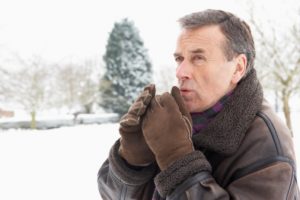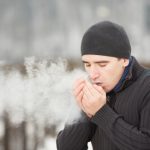 Hypothermia and frostbite are two winter health risks that seniors should be mindful of. Hypothermia occurs when the body’s internal temperature drops abnormally low. Normal body temperature is 98.6 °F (37 °C) and hypothermia is classified with a body temperature below 95 °F (35 °C). Seniors are more susceptible to hypothermia because they have a greater surface area to body weight ratio.
Hypothermia and frostbite are two winter health risks that seniors should be mindful of. Hypothermia occurs when the body’s internal temperature drops abnormally low. Normal body temperature is 98.6 °F (37 °C) and hypothermia is classified with a body temperature below 95 °F (35 °C). Seniors are more susceptible to hypothermia because they have a greater surface area to body weight ratio.
Frostbite occurs when a part of the body actually freezes. Mild frostbite rarely leaves permanent damage but severe frostbite can. In extreme cases, severe frostbite may actually lead to amputation of the affected body part. Smokers, diabetics and individuals with circulatory problems are at a higher risk of developing frostbite compared to others. Serious frostbite can occur within 30 minutes of being exposed to freezing temperatures.
Advertisement
Seniors, in general, have lower body heat, as well as a slew of other conditions that increase their risk of both hypothermia and frostbite. For example, heart problems, thyroid problems and even certain medications can all contribute to a heightened hypothermia risk.
If caught early enough, both winter health risks can be treated and the person can go back to living a normal life. But if not treated right away, there is a higher risk for amputation or even death.
Causes and symptoms of frostbite and hypothermia
 Hypothermia is caused when the body’s temperature drops below normal. Frostbite occurs when a part of the body freezes.
Hypothermia is caused when the body’s temperature drops below normal. Frostbite occurs when a part of the body freezes.
Hypothermia may be hard to spot because it comes on quite slowly. When we are cold our bodies begin to shiver as a means of producing heat. On the other hand, shivering also stops the body from storing energy, so we begin to expel too much energy. Shivering is an early sign of hypothermia, which can be followed by disorientation, confusion, shallow breathing, slurred speech, feeling clumsy, drowsy, or forgetful and having a slow, irregular heartbeat.
Symptoms of frostbite include pain, redness that can turn white or even grayish; the skin may even feel unusually stiff or even waxy. Eventually the body part will go numb.
Body’s cold ‘sensor’ could represent a new treatment for frostbite and hypothermia
Research has found that the body’s cold “sensor” could represent a new treatment for frostbite and hypothermia. The TRPA1 gene was identified as having implications in the response of blood vessels in the skin during the cold. When the body is cold the blood vessels in the skin constrict, limiting the blood supply. When the blood vessels open up again it is called vasodilatation, which warms the skin up again.
When skin is bare to the cold conditions blood flow becomes disrupted, which is what contributes to frostbite. Lack of blood to the tissues is what causes it to freeze.
For the study the skin of anaesthetized mice was exposed to the cold by immersing their paws into water. TRPA1 acted in two different ways: detecting the change in temperature, and stimulating protective constriction of blood vessels. Vasodilatation occurred due to TRPA1 as well.
 Further research is required to determine how targeting TRPA1 could be manipulated to enhance the body’s protective response to cold. Susan Brain, Ph.D., from King’s College London said, “In response to cold weather the body seeks first and foremost to keep the core warm, which means retaining blood close to the center and constricting blood supply to the skin. Our findings highlight the crucial role TRPA1 plays in this physiological response and could pave the way to learn of new pathways that limit the adverse effects of exposure to cold, and potentially the whole body cooling process associated with hypothermia.”
Further research is required to determine how targeting TRPA1 could be manipulated to enhance the body’s protective response to cold. Susan Brain, Ph.D., from King’s College London said, “In response to cold weather the body seeks first and foremost to keep the core warm, which means retaining blood close to the center and constricting blood supply to the skin. Our findings highlight the crucial role TRPA1 plays in this physiological response and could pave the way to learn of new pathways that limit the adverse effects of exposure to cold, and potentially the whole body cooling process associated with hypothermia.”
“Next steps are to build on these promising early findings to learn more about the extent of the role of other TRP receptors in the skin’s response to cold, especially as there is a large family of these temperature sensitive receptors and several of them have their own defined sensitivities to cold. Future research must also investigate the relationship between the vascular responses to cold exposure and the maintenance of skin and body temperatures,” Dr. Brain added.
Treatment and prevention of frostbite and hypothermia
Treatment for frostbite consists of the following:
- Checking for hypothermia
- Protecting the skin from further exposure
- Getting away from the cold
- Gently rewarm frostbitten area
- Take pain medication
- Don’t walk on frostbitten toes or feet – this will lead to further damage
- Removal of damaged tissue – this is done by a medical professional
- Infection-fighting drugs
- Drugs that restore blood flow and prevent blood clots
- Surgery if frostbite is severe
Frostbite prevention tips are:
- Limit time outdoors in cold, windy weather
- Dress in layers
- Wear a hat or headband that covers the ears
- Wear mittens
- Wear socks and sock liners that can keep your feet warm, insulated and dry
- Don’t drink alcohol prior to being outdoors
- Keep moving

Treatment of hypothermia includes:
- If you are helping a person with hypothermia, be gentle as their heart is susceptible to becoming irregular with sudden movements
- Get out of the cold
- Remove wet clothing
- Cover a person with hypothermia in blankets
- Monitor breathing of the person
- Share body heat
- Use warm, dry compresses
- Don’t directly apply heat
- Blood rewarming using a hemodialysis machine
- Warm intravenous fluids
- Airway rewarming using a humidifier
Hypothermia prevention tips include:
- Stay warm in cold weather with layers
- Stay dry in the cold
- Don’t overexert yourself, which can cause sweating and release more energy
- Don’t drink alcohol prior to going outdoors
- If you’re a senior, avoid spending long hours outdoors – stay indoors as long as possible
- Pay attention to wind-chill warnings
If you know any seniors, ensure to check up on them; make sure they are staying indoors and are warm – especially if they have a disability.
Hypothermia and frostbite can be life-threatening, so it’s important to follow these preventative tips to ensure you don’t succumb to the winter cold.
Related Reading:
Norwegian secret to enjoying a long winter
During the winter, many people suffer from season depression thanks to the short and dreary days, so to help us cope experts from Norway have developed a secret: Change your mindset. The findings come from researchers in Tromsø, Norway, where the sun barely breaches the horizon during the winter months due to its northern location. Continue reading…
Advertisement
Winter heart attack risk increases in cold weather
Snow shoveling in the cold weather can increase heart attack risk. Not only can winter be dreadful thanks to dropping temperatures and less sunlight, but we are also forced to spend time outdoors shoveling the continuously growing pile of snow. Already a tedious task, snow shoveling can also prove to be dangerous as it increases the risk of heart attack. Continue reading…
Sources:
http://chealth.canoe.com/condition_info_details.asp?disease
http://gallagherhomehealthservices.com/seniors-at-risk-for-frostbite-and-hypothermia
http://www.medbroadcast.com/Condition/GetCondition/Hypothermia-and-Frostbite
http://www.sciencedaily.com/releases
http://www.mayoclinic.org/diseases-conditions/frostbite/basics/prevention
http://www.mayoclinic.org/diseases-conditions/frostbite/basics/treatment
http://www.mayoclinic.org/diseases-conditions/hypothermia/basics/prevention
http://www.mayoclinic.org/diseases-conditions/hypothermia/basics/treatment
